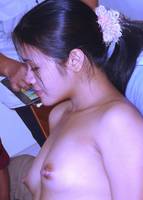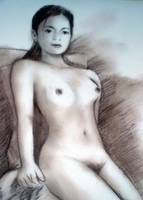THE NUDE IN PHILIPPINE ART
(A Conversation with Manny Duldulao)
by Danny Sillada
Collection by Mr. Eric Cruz. Posted by Hello
Manny Duldulao, art writer and historian, has written extensively on Philippine art and culture. As a self-made man, he is the only non-academe art historian who has written various books in the fields of Art and Culture and whose contribution is beyond compare among his contemporaries and the new generations of art writers.
Manny Duldulao

Photo by Danny Sillada, 2004. Posted by Hello
Manny Duldulao is a legendary name within the circle of collectors - a Godfather to the Filipino struggling and established artists. Through his wisdom and dexterity, he immerses himself within the communities of Filipino artists; he helps and enlightens them to come out their best creative outputs that are reflective of Philippine culture and environment.
Tower of Eden, 2004. Oil on Canvas by Danny Sillada.

Photo by Danny Sillada, 2004. Posted by Hello
A TOYM awardees (Ten Outstanding Young Men) in 1973, Manny Duldulao’s passion and energy never seemed to wane out after several decades of chronicling the Philippine art movements and activities. In his latest book, which will be launched in 2007 titled “The Nude in Philippine Art”; he introduces a fresh concept and development of Nude Art in the Philippines in the context of universal art.
In essence, he explores the attitude and concept of nude art in relation to the artists and their nude models, and the growing awareness of Filipinos especially the collectors toward Nude Art as a form of aesthetic expression.
Nude I, 2004. Pastel on Paper by Allan Flores.

Photo by Danny Sillada, 2004. Posted by Hello
THE DEVELOPMENT OF NUDE ART IN THE PHILIPPINES
The following conversation with the author in January 10, 2005 was a brief glimpse of “The Lives and Loves of Artists and Models” prior to its final publication and launching in 2007.
D.C. SILLADA: What is the main concept of your book on Nude Art in the Philippines?
MANNY DULDULAO:
The main objective of the book, “The Lives and Loves of Artists and Models”, is to place Philippine art in the context of universal aesthetics. That is the reason why I developed the book by showing masterpieces of nude paintings around the world from Spain to Parish to New York and, then, juxtapose them in the context of Philippine art movement.
All of the paintings that I am featuring in the book are full-blown artworks in the respective style of the Filipino artists. I don’t feature sketches or drawings because we cannot elevate Philippine art into a universal level if we are going to show minor pieces.
Nude painting in the Philippines is relatively a recent activity. It only came out in the 1980s and before that, from the 1930s to 1950s, there were not much movement especially in the academe like the University of the Philippines because they could hardly get a Filipina model to pose for the Fine Arts students.
D.C. SILLADA: What is the attitude and concept of Nude Art amid our conservative culture from 1930s through 1970s and 1980s onwards?
Desnuda, 2004. Oil on canvas by Danny Sillada.

Photo by Danny Sillada, 2004. Posted by Hello
MANNY DULDULAO:
Nude paintings in 1950s and 1960s, I would say, were practically academic. They were for studies of human anatomy along the lines of academic requirement, and not for the purposes of gallery exhibitions.
It was only in the 1970s with the organization of the Casa de Oro Group, which is currently known as the Saturday Group, under Alfredo Roces, Hernando Ocampo and Cesar Legaspi, when the nude as an art form began to emerge. Other artists took it from there like the group of Ernie Tagle; they took serious undertaking of giving the nude art form its due in the Philippine art movement.
I would, therefore, say that the flowering of the nude as an art form by itself began in the 1970s and blossomed around 1978 to 1979 and, then, started to have a heavy solid footing in the Philippine art market around the early 1980s.
Now, of course, anything goes... In fact, you can find nude session almost everyday and the artists are no longer looking at it as a form of exercise, but simply as an exploration of art form.
Marina, The Model. Photo by Danny Sillada, 2004.

Posted by Hello
D.C. SILLADA: The Filipina nude models: how they respond in exposing their naked bodies in front of the artists, considering our conservative culture toward nudity?
MANNY DULDULAO:
In the 1950s, you could count on your fingers the girls who were posing in the nude, and they were mostly posing in academic classes like UP. However, it was only during 1970s that modelling became a profession, and one of the legendary pioneers is Nellie Sta. Maria.
When the girls realized that it was a serious undertaking and they could earn some good money in the process, many of them started modelling professionally for a moderate fee. Consequently, they were getting regular assignments especially with the group of Tagle, and they were common girls, not in the entertainment profession.
The girls were mostly students who put their trust on the integrity of the artists. One of them was a niece of the late art critic Lorna Revilla Montilla. She was fondly called Inday. One time, the model that they were waiting did not arrive so Lorna told her niece “O, Inday ikaw na lang ang mag-pose...”
It was the beginning of her modelling career that eventually prospered. Now, some girls took it as a profession: they are no longer embarrassed disrobing in front of the artists.
Today, Filipina movie stars pick up the modelling stints; so you can count on them as regular sitters. Girls like Tracey Torres, Julia Lopez, Rosanna Roces, Andrea del Rosario, Katya Santos, Honey Miller, the controversial Keana Reeves and Rose Valencia, they all posed in the nude sessions.
Nude II,2004. Watercolor on Paper by Gene de Loyola.

Photo by Danny Sillada, 2004. Posted by Hello
D.C. SILLADA: What is your main thrust in the book in relation to the artists and their nude models?
MANNY DULDULAO:
After reading several literatures on nudes, I found out that art authors and historians concentrated on the human body as a source of art form. What I did with my book, I researched on the lives of nude models.
Like, for instance, the famous painting of Sandro Botticelli titled “The Rising of Venus”; I was able to gather enough information as to who the model is and the family where she belongs to. Likewise, the model of Édouard Manet and his controversial painting “The Luncheon on the Grass”: who is she and what is her name?
These are essentially the main thrusts of my book: the artists, the models and their symbiotic relationships that create a compelling history and developments of nude art from ancient time to postmodern period.





4 comments:
Beautiful blog, just loved it. you defenitly have a artistic soul.The paintigs are suberb also the pictures, very well chosed indeed.
Keep the good work.
Warm regards:
Dinah Raphaellus
manny duldulao is my grandfather
Has manny duldulao really featured the best painters in the country without their having to pay him? Sometimes his books are a catalogue for painters who can afford the ad space in his books.
In all of his books on art, National Artists and other famous Filipino painters, who contributed to the early and recent development of Philippine art are featured in his books. Contemporary and emerging artists who wanted their paintings to be featured on his books are asked to give a painting in exchange of a page with brief biography.
Post a Comment